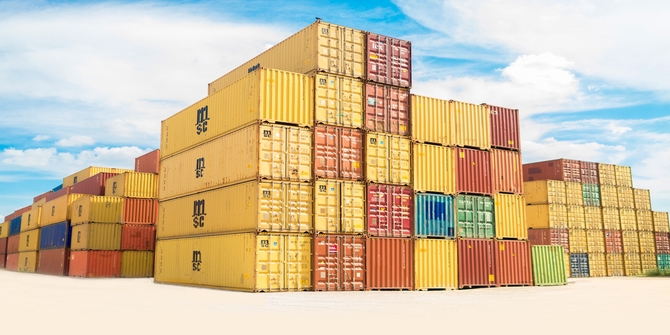In order for the Hambantota port project to reap potential benefits for Sri Lanka and the regional economy, there are three crucial aspects: bunkering operations, completion of the wider Hambantota development project beyond the port, and trans-shipment of goods argues Nilanthi Samaranayake.
Sri Lanka, at present, is rebounding from an unprecedented political crisis. The episode, in part, brought into focus the country’s debt crisis. While Colombo has never defaulted on a loan, it owes billions of dollars to foreign lenders that are coming soon by 2023. Amid this crisis, the International Monetary Fund suspended a bailout package, and agencies such as Moody’s downgraded Sri Lanka’s credit rating.
The issue of Sri Lanka’s debt surfaced dramatically a year ago when the government struck a deal to lease the controversial Hambantota port to a Chinese state-owned enterprise. The joint venture has been justifiably criticised for a number of reasons, not least of which is the decision to offer an inordinately lengthy 99-year term to a country whose expanding presence in the Indian Ocean is causing concern in neighbouring India. Yet, well-founded arguments highlighting the risks of the lease often overlook the potential upside from the port, if well-managed under the new agreement.
 Photo: Assorted-colour filed intermodal containers | Credit: Unsplash
Photo: Assorted-colour filed intermodal containers | Credit: Unsplash
On the one-year anniversary of the transfer of operational control of the Hambantota port, it is important for policymakers in India, the United States, and other regional stakeholders to consider the potential for Hambantota to be a case where a smaller Indian Ocean state — operating in an environment of major powers — can leverage its infrastructure for regional benefit. With sufficient commitment, the port could possibly even function as a critical node in an increasingly integrated regional economy.
From one year ago to the present
In December 2017, Sri Lanka formally turned over operational control of the Hambantota port to a Chinese-majority joint venture under a 99-year lease in exchange for roughly $1 billion in foreign direct investment (FDI). Hefty loans to multilateral development banks were due, and the country desperately needed FDI to address foreign exchange reserve and balance-of-payment problems. Although the 99-year term is objectively unfavourable and heightens concerns about whether Sri Lanka is falling into a “debt trap” to China, the deal enabled an easy infusion of FDI — which has proved difficult for the country — and breathed new life into stalled efforts to develop the port. Sri Lankan leaders also saw China Merchants Port Holdings as the best company to revitalise the project, based on its success in operating a terminal in the port of Colombo, which is a major hub of regional trans-shipment — a significant proportion of which goes to India.
One year later, roughly the same number of ships have visited Hambantota port. This suggests that, at present, little has changed on the ground in terms of commercial activity. Most of the ship traffic comes from roll-on, roll-off operations for cars being trans-shipped from Asia — Japan, India, and South Korea — and destined for East Africa.
India should take note of the potential implications of projects where China has played a major role, but where the beneficiaries could be India, among other regional stakeholders such as Japan and the United States. The country began preparations to move the Southern Naval Area Command based in Galle to Hambantota in 2016, before the renegotiated port agreement. Naval Detachment Hambantota was stood up in June 2016 and continues to grow in stationed personnel. Moreover, under the International Maritime Organization’s International Ship and Port Facility Security (ISPS) Code, the Sri Lanka Navy continues to provide security for the Hambantota port, as it does with other ports in the country. Even if China did manage to exploit its commercial position in Hambantota to establish a military presence, India’s naval capabilities and land-based air power could eviscerate a Chinese base here in wartime.
Future prospects
In order for the Hambantota port project to reap potential benefits for Sri Lanka and the regional economy, a few things need to take place.
First, bunkering operations are set to resume under the new management group and will be critical to the port’s success. Total ship arrivals to Hambantota port had actually increased in 2012-2014 before declining in 2015-2017 due to the new government’s decision to halt fuel-bunkering operations. This activity was the very purpose of the port in President Chandrika Kumaratunga’s negotiations with Beijing in 2005 — before Rajapaksa’s presidency.
Second, completion of the wider Hambantota development project beyond the port — to include a highway, LPG transshipment terminal, LNG plant, and industrial zone — will be important for promoting its growth. Sri Lankan development planners have detailed the problems with how the Hambantota project was carried out. A British firm is developing a master plan for the district that can draw on these lessons learned in order to position the project for wider regional success. Highway expansion from Matara to Hambantota is visible, and railroad expansion from Matara to Beliatta is almost complete. These initiatives will increase internal connectivity, providing direct links between Colombo and Hambantota. The Chinese-backed Southern Expressway has already reduced the time to travel between the two locations to roughly four hours, and the travel time will likely drop to 2.5 hours upon completion. The highway is also expected to boost tourism to the east, as Hilton Doubletree plans a new hotel in Hambantota district.
Finally, the port’s largest business at present is trans-shipping automobiles built in Asia to East Africa. A substantial majority of the business is Japanese, followed by Indian (from Chennai). Mainline operators use Hambantota due to the significant yard space for roll-on, roll-off shipping, unlike in Colombo. Ultimately, the shipping industry will determine the business viability of this port and surrounding zone. But for strategists, this Japanese and Indian activity suggests that Hambantota — despite Chinese investment and majority control — could become a critical node in the Asia-Africa Growth Corridor (AAGC). Japan and India envision the AAGC as a transparent, sustainable alternative to China’s Belt and Road Initiative (BRI) for improving connectivity within the Indo-Pacific region. Could Hambantota be an example of how other Chinese-backed projects can be used to advance a competing vision for the regional geo-economic order?
Given India’s wider interest in increasing connectivity in South Asia — one of the least integrated regions in the world — the potential upside of the development of Hambantota port should at least be considered. This is especially the case from the perspectives of smaller Indian Ocean states that do not wish to choose sides in a 21st-century “Great Game.”
This article first appeared ahead of Raisina Dialogue on the Observer Research Foundation.
This article gives the views of the author, and not the position of the South Asia @ LSE blog, nor of the London School of Economics. Please read our comments policy before posting.
Nilanthi Samaranayake is an Indian Ocean security analyst at CNA, a non-profit research organisation in the Washington DC area @nilanthis





